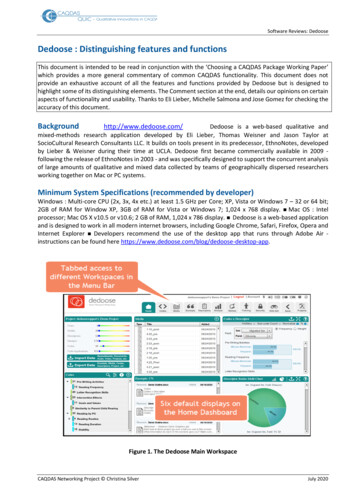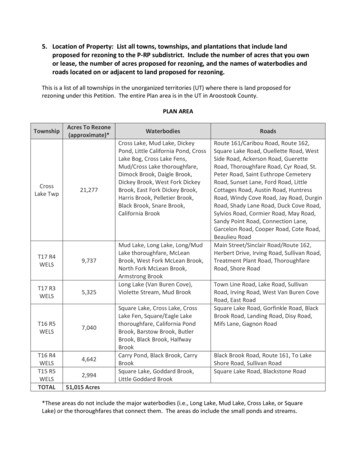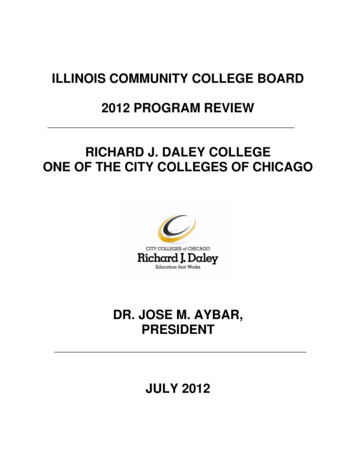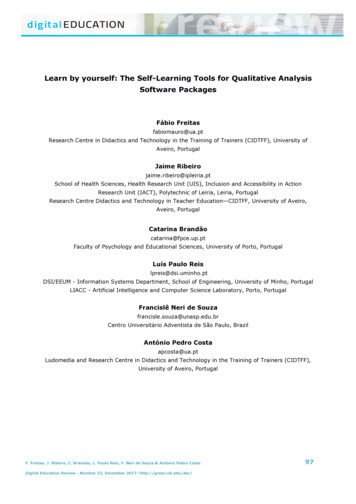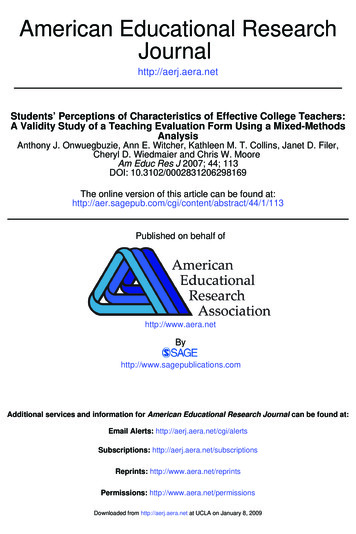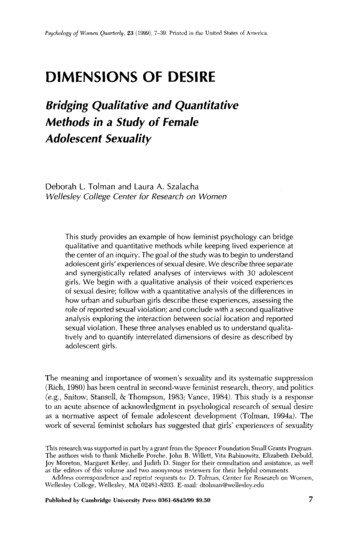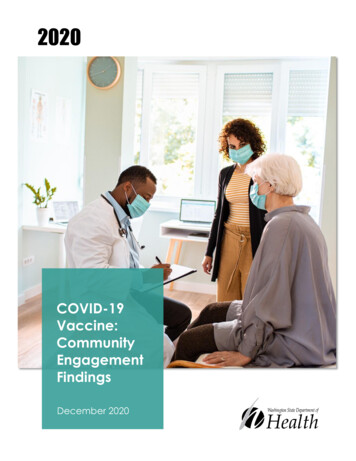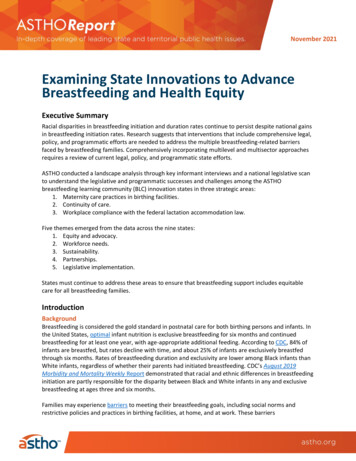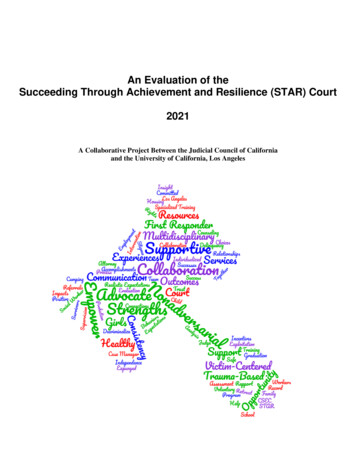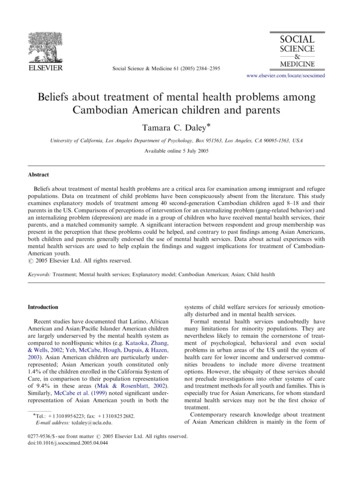
Transcription
ARTICLE IN PRESSSocial Science & Medicine 61 (2005) s about treatment of mental health problems amongCambodian American children and parentsTamara C. Daley University of California, Los Angeles Department of Psychology, Box 951563, Los Angeles, CA 90095-1563, USAAvailable online 5 July 2005AbstractBeliefs about treatment of mental health problems are a critical area for examination among immigrant and refugeepopulations. Data on treatment of child problems have been conspicuously absent from the literature. This studyexamines explanatory models of treatment among 40 second-generation Cambodian children aged 8–18 and theirparents in the US. Comparisons of perceptions of intervention for an externalizing problem (gang-related behavior) andan internalizing problem (depression) are made in a group of children who have received mental health services, theirparents, and a matched community sample. A significant interaction between respondent and group membership waspresent in the perception that these problems could be helped, and contrary to past findings among Asian Americans,both children and parents generally endorsed the use of mental health services. Data about actual experiences withmental health services are used to help explain the findings and suggest implications for treatment of CambodianAmerican youth.r 2005 Elsevier Ltd. All rights reserved.Keywords: Treatment; Mental health services; Explanatory model; Cambodian American; Asian; Child healthIntroductionRecent studies have documented that Latino, AfricanAmerican and Asian/Pacific Islander American childrenare largely underserved by the mental health system ascompared to nonHispanic whites (e.g. Kataoka, Zhang,& Wells, 2002; Yeh, McCabe, Hough, Dupuis, & Hazen,2003). Asian American children are particularly underrepresented; Asian American youth constituted only1.4% of the children enrolled in the California System ofCare, in comparison to their population representationof 9.4% in these areas (Mak & Rosenblatt, 2002).Similarly, McCabe et al. (1999) noted significant underrepresentation of Asian American youth in both the Tel.: 1 310 895 6223; fax: 1 310 825 2682.E-mail address: tcdaley@ucla.edu.systems of child welfare services for seriously emotionally disturbed and in mental health services.Formal mental health services undoubtedly havemany limitations for minority populations. They arenevertheless likely to remain the cornerstone of treatment of psychological, behavioral and even socialproblems in urban areas of the US until the system ofhealth care for lower income and underserved communities broadens to include more diverse treatmentoptions. However, the ubiquity of these services shouldnot preclude investigations into other systems of careand treatment methods for all youth and families. This isespecially true for Asian Americans, for whom standardmental health services may not be the first choice oftreatment.Contemporary research knowledge about treatmentof Asian American children is mainly in the form of0277-9536/ - see front matter r 2005 Elsevier Ltd. All rights reserved.doi:10.1016/j.socscimed.2005.04.044
ARTICLE IN PRESST.C. Daley / Social Science & Medicine 61 (2005) 2384–2395service utilization and prevalence studies. However, atleast two studies have examined beliefs about treatmentof child problems among Asian American or Asianpopulations. McKelvey, Baldassar, Sang, and Roberts(1999) found that Vietnamese parents in Australiaactually endorsed a high preference for Western practitioners including mental health clinics, psychiatrists,hospitals, and psychologists. Religious practitioners,naturopaths/homeopaths and spiritual healers were theleast likely to be sought. Awareness of child andadolescent mental health services was very low amongparents. Also using a community sample, Lau andTakeuchi (2001) used vignettes to assess the relationshipbetween values and help-seeking behavior amongChinese American parents. As with the findings ofMcKelvey et al., these authors did not find a relationship between a more traditional value orientation andless willingness to seek mental health services. Instead,perceived severity of the problem was the factor thatbest predicted help-seeking. In general, given theunderutilization of services among Asian Americans, itis surprising that more studies have not sought toinvestigate beliefs about the usefulness of the mentalhealth system for treatment of child mental healthproblems among Asian Americans.Among Asian Americans in the United States,Cambodians have increasingly received attention as anespecially high-need group (US DHHS, 2001). Economically, Cambodians on average fall well below thepoverty line (Chan, 2003) and in Los Angeles county,rank lower than all other ethnic groups on almost everysingle indicator of economic and social adjustment(Louie, 1996). High levels of exposure to violence(Berthold, 1999) and significant rates of Post-TraumaticStress Disorder (PTSD) and depression have been notedin nonclinical samples (Berthold, 1998). Cambodianyoungsters are also exposed to varying levels of anxiety,depression and PTSD in their parents as a result oftorture experienced during the ‘‘killing fields’’ of the1970s (Kinzie, Boehnlein, & Sack, 1998). Gang activityhas been identified as a particular concern by Cambodian parents (Chan, 2003). While many Cambodianchildren are referred for services, among childrenattending an Asian-specific clinic, Southeast Asianclients show less benefit from services than other Asiangroups, suggesting that even specialized ‘‘parallel’’services may not effectively serve the needs of Cambodian children and adolescents (Yeh, Takeuchi, & Sue,1994).While the economic, historic, and social realities ofthe Cambodian community point toward elevated levelsof mental health problems in children, there are gaps inwhat is known about this issue. To date, the extensiveresearch on Cambodian youth has focused on childrenand adolescents who themselves were refugees, ratherthan the generation of Cambodian youth born in the2385US. These youth may have different or additional issueswith which they struggle than refugee populations. Inaddition, virtually no data are available on treatment ofchild problems among Cambodians settled in the USbeyond what we know about the previous generation ofadolescent refugees. It is unclear how parents believemost child problems should be handled: within thehome, at school, in outpatient clinics, through parallelservices, elsewhere, or not at all.One avenue through which to explore beliefs aboutmental health stems from the explanatory model framework (Kleinman, 1980). An explanatory model is a wayto characterize a personal belief system about an illnessor illnesses, and traditionally refers to five areas:etiology, time and mode of symptom onset, pathophysiology, course of sickness and treatment. With roots inmedical anthropology and health psychology, theframework has also been incorporated into the mostrecent edition of the Diagnostic and Statistical Manualas part of the recommended practice for establishingcultural factors that may be associated with a psychiatricdiagnosis. Research has previously examined parentalbeliefs about childhood mental illness and behavior,including ADHD (Bussing, Schoenberg, Rogers, Zima,& Angus, 1998), generally ‘‘deviant’’ behavior (Hackett& Hackett, 1993), mental illness (McKelvey et al., 1999),as well as a range of physical problems in children.A major impetus for the focus on explanatory modelsin both the original conceptualization (Kleinman, 1980)and in the current study is that this framework holdspotential for improved service delivery and clinicaloutcome for clients. In particular, the ExplanatoryModel component of beliefs about treatment may havethe most immediate relevance for addressing challengessuch as those faced by Cambodian youth because thespecific questions probe for ideas about how to alleviatedistress. Past research on Cambodian populations haveincorporated different aspects of the explanatory modelparadigm to understand adult treatment beliefs. Forexample, Eisenbruch (1992) used multidimensionalscaling to classify 45 perceived causes of illness intofour categories: Western physiological, nonWesternphysiological, stress, and supernatural. Cheung andSpears (1995) subsequently found that 78% of Cambodian adults had beliefs that could be classified in all fourcategories. This finding helps explain earlier results byKinzie (1985) in which there were significant discrepancies in concepts of mental health between mental healthprofessionals and Khmer refugees.Despite the utility of explanatory models withCambodian populations, no studies have focused onCambodian beliefs about child problems or Cambodianchildren’s own beliefs. The aim of the current study is touse a mixture of rating scales with analyses of qualitativedata to examine beliefs about treatment of mental healthproblems among refugee Cambodian parents and their
ARTICLE IN PRESS2386T.C. Daley / Social Science & Medicine 61 (2005) 2384–2395American-born children. The focus of comparison inthis study is twofold: first, we compare parents andchildren, given that differences in beliefs about treatment could impact the effectiveness of certain strategies(Lau & Takeuchi, 2001). Understanding these differences may be the first step to reconciling them. Second,we compare children and parents who have directexperience with mental health services with a carefullymatched control group. By tapping into the beliefs ofthose with direct experience, we can asses which aspectsof mental health services are viewed positively and whichare viewed negatively, and may also find that Cambodian children and parents see value in other sources ofhelp that can operate in tandem to or in lieu of formalmental health services. The inclusion of a control groupalso allows for greater generalizability. Through the useof vignettes, we explore the extent to which two commonproblems are perceived as ‘‘helpable,’’ that is, how theyare thought to be remedied through different treatmentoptions. Then, through the analysis of both qualitativeand quantitative data, we examine which strategies orservices Cambodian children and parents perceive as themost useful for addressing these problems.MethodParticipantsForty parent–child dyads were recruited to participatein the study. Twenty children of Cambodian origin wererecruited from two community-based, Asian-specificmental health agencies. One was a Department ofMental Health (DMH) agency, and the other was anonprofit agency with a DMH contract. Children wereconsidered eligible for participation if they were betweenthe ages of 8–18, lived with at least one biologicalparent, and did not have a primary diagnosis of acognitive impairment or thought disorder. The parentsof eligible children were contacted either in person or byphone by the clinic case manager. Consent to releaseclients’ phone numbers to the project staff was obtained,and a research assistant from the project contactedparents to further explain the study and ascertaininterest in participating. An estimate provided by thecaseworker suggests that approximately 75% of clinicfamilies agreed to be contacted and 100% of the familiescontacted by the research team chose to participate.Clinic children were primarily referred from theirschools (N ¼ 8). Five entered services through a legalavenue such as Department of Children and FamilyServices or probation, and five had services initiated bytheir parents. The referral source for two cases waseither unclear or conflicting between reports. Of thediagnosis provided at intake, 70% of the clinic sampleevidenced an externalizing problem, and 25% aninternalizing problem as their primary diagnosis, adistribution which is typical for outpatient child mentalhealth clinics (Manteuffel, Stevens, & Santiago, 2002).Table 1 presents diagnostic information from chartrecords at intake.Twenty community participants were recruited toserve as a matched control group and were recruitedthrough strategies such as distribution and posting offlyers at temples, churches, apartment complexes,community centers and businesses in the main Cambodian community, recruitment at school and communityevents, and snowball sampling with multiple originatingpoints selected to maximize the likelihood of obtaining aheterogeneous sample that met the criteria needed formatching purposes. Groups were matched on childgender (3 girls, 17 boys) and matched within 6 months ofTable 1Sample characteristics (N ¼ 40)Clinic M (SD) CommunityN ¼ 20M (SD)N ¼ 20Child ageAge of parent respondentParent respondent years ofeducationParent respondent number ofyears in USNumber of living children ofmotherNumber of householdmembersAnnual income13.69 (2.26)46.23 (7.99)4.25 (3.81)13.71 (2.33)43.19 (7.85)5.15 (3.38)18.62 (2.87)18.48 (2.59)4.35 (1.87)5.10 (1.68)5.03 (1.95)5.91 (1.77) 20,444( 6640)55% 20,853( 6345)55%Percent of single parenthomes (N ¼ 40)Percent of homes with no85%parent employed (N ¼ 40)Percent of homes with Khmer 65%areported spoken by bothparents and children (N ¼ 40)55%bPrimary DSM-IVclassification of child clinicalsample at intakeOppositional defiant40%disorder (N ¼ 8)ADHD (N ¼ 5)25%Depressive disorder NOS15%(N ¼ 3)Dysthymic disorder10%(N ¼ 2)Conduct disorder (N ¼ 1) 5%Adjustment disorder5%(N ¼ 1)aParent report.Child report.b60%60%a60%b
ARTICLE IN PRESST.C. Daley / Social Science & Medicine 61 (2005) 2384–2395child chronological age; the average age differencebetween groups was less than 1 month. Communitychildren could not have received any services from eithera community or school-based program for behavioral,emotional or mental problems at any time in their life.The samples were comparable on reported income perperson, parent years of education, age of parent atarrival in the US, language spoken in the home, andreligion. In addition, the families were well matched forthe number of years of residence in the US, thehousehold size, and number of children in the family;there were no significant differences among any of thesevariables.The mean age of children in the study was 13.71(SD ¼ 2.27). Mothers were always the respondentchosen for interviewing in two-parent homes given thatthey were self-identified or identified by the clinic asbeing the primary caregiver and responsible for thechild’s clinic treatment. Half of both groups were singleparent homes which included single fathers. Parentshave lived in the US an average of 18.55 years(SD ¼ 2.69); all children in the sample were either bornin the US or in two cases, arrived before the age of 6months and in one case, arrived at the age of 3 years.Families reported a mean combined household income(including sources such as cash assistance, SSI, and foodstamps) of 20,648 for a family of 5.4. Seventy-threepercent of the sample was families in which both parentsor the only caregiver was unemployed. There was nodifference in the distribution of working and unemployed single and two-parent homes between the groups(see Table 1).Procedure and measuresParents and children were interviewed separately intheir homes. A research assistant who fluently spokeKhmer (the Cambodian language) was present for allparent interviews. Parents were encouraged to speak inwhatever language they preferred, or a combination ofboth languages. Seventy-one percent of the interviewswere conducted exclusively in Khmer, 29% of theinterviews involved a mixture of English and Khmer.All child procedures were conducted in English by theprimary investigator and were not attended by any otherindividuals. Parents reported on basic demographicinformation such as the child’s date and place of birth,school, grade, mother’s and father’s date and place ofbirth, occupation, total years of schooling, ethnic groupidentification of the parents, religious affiliation ofparents, approximate household income, number ofhousehold members and number of children.Measurement of beliefs about treatmentThe research tool for obtaining information aboutexplanatory models of treatment was a modified version2387of the Explanatory Model Interview Catalogue, a semistructured interview that has been developed to elicitillness-related perceptions, beliefs and practices (Weiss etal., 1992). Two vignettes were used. By basing thevignettes on data collected through a chart review of allthe current clients at one of the clinics, it was possible tomake these vignettes reflective of actual and significantproblems of Khmer children. Descriptive clinical information from the presenting problem reported at thefirst session was used as the basis of the vignette toapproximate the most common problems seen.The vignettes represent a general externalizing(‘‘Sombo’’) and internalizing child (‘‘Jauna’’). Ages usedin the vignettes are averages of the actual ages ofchildren at time of presentation. As a result, the age ofthe children in the two vignettes differs, but provides amore realistic reflection of actual Cambodian childrenthan would be achieved by using identical ages. Thevignettes were discussed with three Khmer child mentalhealth professionals to ensure accuracy, and modifications were made. The order of presentation of the twovignettes was counterbalanced within the two samples,and parents and children received the vignettes in thesame order. They appear in Appendix A.Both parents and children were asked, ‘‘What kind ofhelp or treatment do you think would be best for /VIGNETTE NAME’SS behavior?’’ Following their responseto this open-ended question, respondents were provideda list of different treatment options and were asked torate from 0 to 4 how helpful they thought each would befor the child in the vignette. For the options receivingthe highest endorsement, respondents were asked howthey thought that could help the child in the story.Respondents were also asked to rank and explain anyitems they volunteered that were not already on the list.Items chosen for the list included the most commonoptions for children experiencing a behavioral oremotional problem, and also included any sources ofprevious help obtained from a chart review conductedbefore the study.Responses to the open-ended question were codedinto one of seven categories using a bottom-upprocedure (see Appendix B). Coding was completed bytwo Cambodian-American assistants, who were blind togroup membership of the respondents. Interrater reliability for the coding scheme was high; k ¼ :91 for parentand k ¼ :86 for child coding. Respondents were offered13 treatment options; following data collection, thesewere collapsed into seven categories. Where more thanone item is present, the items were averaged: (1) religious(priest or monk); (2) school (child or parent approachingteachers and school personnel); (3) friends (child orparent approaching child’s friends); (4) doctors (takingmedicine or going to a pediatrician); (5) traditionalCambodian options (a kruu khmer, Cambodian medicine, cupping/pinching/coining); (6) mental health ser-
ARTICLE IN PRESS2388T.C. Daley / Social Science & Medicine 61 (2005) 2384–2395vices, and (7) parents in general. These categories are notabsolute or devoid of overlap, of course; for example, itis also possible that one way a parent could be helpful isby talking to teachers. They are used as a convenientframework for comparison.The SPSS 11.5 statistical program was used foranalysis of quantitative data, and the EthnoNotes(Lieber, Weisner, & Presley, 2003) was used for analysisof the open-ended questions.ResultsExtent that problem can be helpedOne question of this study asks to what degree each ofthe two children presented in the vignettes is viewed asbeing able to be helped. To determine this, an averagescore was derived from the list of possible sources ofhelp, plus any others mentioned. The design is a 2 2(respondent clinical status) multivariate analysis ofvariance (2-way MANOVA) to determine the effect ofthe respondent (parent/child) and clinical status (clinic/community) on the two dependent variables, the degreethat the children portrayed in each of the externalizingand internalizing vignettes can be helped. A multivariatetest for respondent was not significant (Wilks’Lambda ¼ .973, F ¼ 1:021, df ¼ 2.75, p ¼ :36). Therewas also no main effect for clinical status (Wilks’Lambda ¼ .970, F ¼ 1:151, df ¼ 2.75, p ¼ :32). However, a significant respondent by clinical status interaction was present for the perception that the child in bothvignettes could be helped (Wilks’ Lambda ¼ .864,F ¼ 5:922, df ¼ 2.75, po:005). For both the internalizing and externalizing vignette, the pattern of responsewas the same: parents in the clinic sample reported thehighest score, followed by community children, clinicchildren, and lastly, community parents. Among thefour groups, mean scores ranged from 1.63 to 2.17 forthe externalizing child and 1.66 to 2.33 for theinternalizing child, where ‘‘0’’ signifies ‘‘not at all’’ and‘‘4’’ signifies ‘‘very much’’. Table 2 contains the meansand the standard deviations of the DV’s for the fourgroups and Fig. 1 depicts the interaction.Helpfulness of different treatment choicesThe second question of this study examines parentand child beliefs about what specific interventions andstrategies are perceived as most useful for the problemspresented in the vignettes, and why. To address thisquestion, two types of data are presented: a descriptivecomparison of the strategies suggested from open-endedresponses and endorsement of a list of treatmentoptions.Table 2Means and standard deviations of perceived potential ofvignette children to be helpedMSDExternalizing vignetteClinic parentCommunity parentClinic childCommunity child2.171.632.062.17.85.56.66.71Internalizing vignetteClinic parentCommunity parentClinic childCommunity .2ExternalizingClinical ing1.6parentchildMemberFig. 1. Average ability to be helped for children depicted inexternalizing and internalizing vignettes.Strategies from open-ended responsesThe open-ended responses were coded for the primaryapproach to treatment that participants felt would behelpful. In general, the pattern of responses was similarbetween groups, and for clarity of presentation, themain comparison will be between parents and children.The use of formal services and informal guidanceemerged as the two most common suggestions, exceptfor children’s response to the externalizing vignette. Forthis vignette, children most frequently recommendedrestriction and punishment. As will be discussed below,mental health providers were often seen as a usefulstrategy; more than a third of the parent responses andabout a quarter of the child responses for both reflecteda formal treatment, such as an agency or facility whosepurpose was to provide services (see Fig. 2). A smallnumber of these responses included churches or temples,but the overwhelming majority of formal servicesmentioned were in the mental health profession.
ARTICLE IN PRESST.C. Daley / Social Science & Medicine 61 (2005) alizingNumber of cetuidgusealmForraanrviccees0Fig. 2. Primary strategy for intervention from open-ended responses.Almost as consistently, parents and children recommended the strategy of providing informal guidance(‘‘talking it over’’), with a family member, friend, oranother adult, such as a parent who recommended,‘‘talking to him and guiding him, the parents need toguide and advise the childythen you’re gonna have toask him and take time to ask him what’s going on, andsay ‘Son talk to me what did you do wrong, tell us andwe’ll help you’ then the child will be more relaxed, incase if he did do something wrong he can go back anddepend on his parents to support him and help him.’’Another parent echoed this idea by noting that ‘‘thechild doesn’t want to talk to the parents so if there isn’tanother person like an uncle who he may talk to, youhave to ask the other people like neighbors or friends tohelp you by asking the child and talking to the child.’’Children similarly suggested ‘‘family talk’’ or friends tosteer him out of trouble.Restricting behavior and punishment was brought upas an effective strategy, but this was more so for thechild in the externalizing vignette and particularlyamong children, nearly a third who suggested it.Thirteen children responded that ‘‘boot camp’’ was away to help the child in the externalizing vignette; anadditional three responded ‘‘jail,’’ and various othertypes of punishment or discipline were noted, such asputting the child in a special class with a mean teacher,solitary confinement, giving him a ‘‘whopping,’’ andtaking him to police officers, an option mentioned byfive kids. One parent explained that ‘‘if the child doesn’tlisten to the parent, send her to boot camp for a fewmonths, and then she comes back, she’s okay.’’ Oneyoungster described the mechanism of effectiveness ofboot camp as ‘‘they discipline kids who are aggressiveand hard-headedy[it would help because] the kids justget a lot of discipline, exercising, and being respectful topeople. If they don’t be respectful, the soldiers orwhatever, the sergeants, they’re loud.’’ Children frequently mentioned not allowing the child in theexternalizing vignette to go outside, and while lessfrequent, some parents expressed the idea, ‘‘that childneeds someone to teach him a lesson.’’At the other end of the spectrum from restriction andpunishment, indulgence and nurturance was suggested,particularly for the child portrayed in the internalizingvignette. Parents and children both recommended‘‘give(ing) the children money, food, or whatever theywant,’’ ‘‘just do what makes him more happy,’’ and ‘‘lethim stay home and have games and food in the house,let him eat well and if he needs or want something, giveit to himy care about him and give him attention andask him questions on what he wants so he won’t be sador upset and take him to the park to play around andstuff,’’ as described by parents. Emotional nurturancewas suggested for ‘‘Sombo’’ as well, such as a parentnoting that ‘‘since he’s already like this, you will justneed to sweet talk him.’’ One youngster replied that‘‘he’ll probably need his parents to tell him that they
ARTICLE IN PRESS2390T.C. Daley / Social Science & Medicine 61 (2005) 2384–2395love him and stuff like that, and like let him kick it withthe right crowd’’ another noting the importance of‘‘someone just going out to him and talking to him,asking about how he feels. Why he feels that way, justasking why he doesn’t associate with so many kids, whyhe’s so emotional; a person who actually cares and issincere in his questions or his or her questions. Not justsomeone who says, ‘why are you acting this way, I wantyou to be better.’ Someone who actually cares abouthow he feels.’’While not as commonly mentioned, the strategy ofdistracting the child, either through getting him or herinterested in something else or changing the environment (for example, relocating the child to live withanother family member or changing neighborhoods) wassuggested as a way to help, especially by children whoviewed bad neighborhoods as the cause of the problemand felt that ‘‘it’s best if they move out of whateverneighborhood they’re in and go to another peacefulneighborhood. And let him kick it with a goodsurrounding and um, just give it like a month and he’llstart changing the way he behaves.’’ Distracting alsoincluded ideas such as ‘‘hav(ing) fun, go to places,pools,’’ and getting ‘‘a lot of clowns and all this stuffthat makes him really happy and everything elseylikesome funny jokes, some funny movies and also get someexcitement. Make some funny faces so he’ll make somefriends; that might make him really happy.’’ In sum, theopen-ended responses were dominated by reliance onformal services and informal guidance, although bothextremes of punishment and indulgence were alsoinvoked.Endorsement of list itemsAcross the groups and across the vignettes, mentalhealth services, which were described as ‘‘a counselor,psychologist or mental health center’’ were chosen asamong the most helpful. For parents, this option wasranked most popular in both the community and clinicsamples; parents in the clinic sample expressed the mostfaith in mental health services with a mean of 3.48 out ofa possible 4 (differences between the clinic and community sample will be discussed below). Among children,mental health was selected either first of second highestfor the internalizing child. The explanations of howmental health services would help centered on the ideathat they were trained to help ‘‘this kind of kid’’ andwould be able to ‘‘guide and help and talk good to leadthe child to a good path for him to calm down.’’ Forexample, parents suggested that for externalizing problems, ‘‘they can guide the child to do good, and theycan give examples to the child, helping the childdistinguish from good to bad, and when the child seesthat, it’ll work.’’ Similarly, for internalizing problems,parents noted, ‘‘from what I hear about it, they helpwith not letting the child think too much, and thinkpositive’’ and that ‘‘the counselor will already knowwhat’s going on with the child’s problem so they can talkto the child and guide him a lot, they can talk good tohim.’’Children’s responses tended to be less elaborate as tothe mechanism by which mental health services couldhelp, although some youth were able to articulatereasons such as ‘‘they’re trained to deal with this kindof situation or similar situations to him, so they wouldknow if he really needed help, or if he could just handleit himself’’ and ‘‘if the social worker or psychologist issincere, I think that would be beneficial and als
SocialScience&Medicine61(2005)2384-2395 Beliefsabouttreatmentofmentalhealthproblemsamong CambodianAmericanchildrenandparents TamaraC.Daley University of California .
